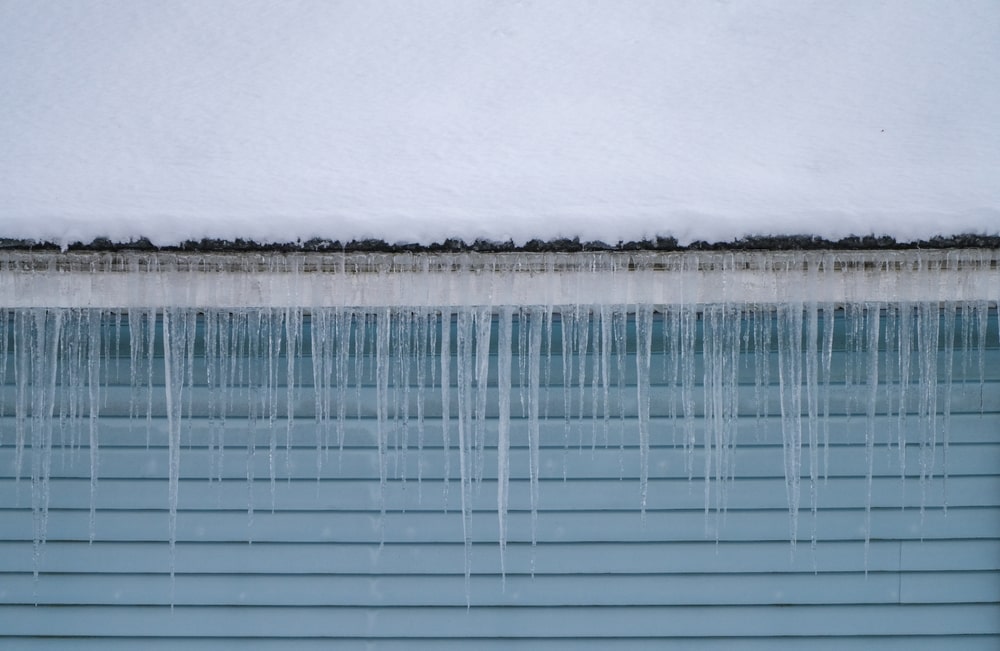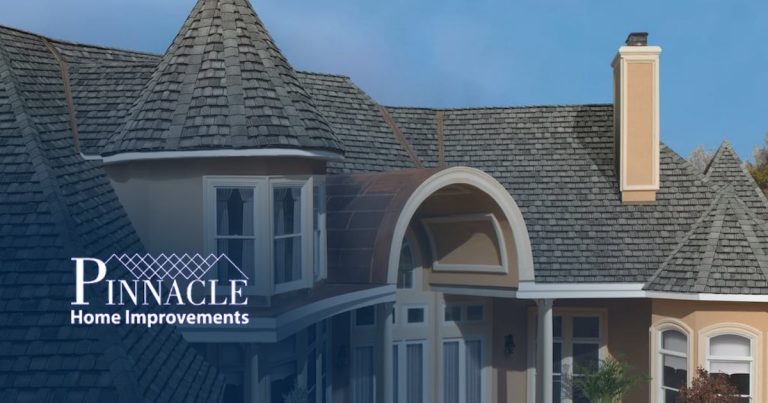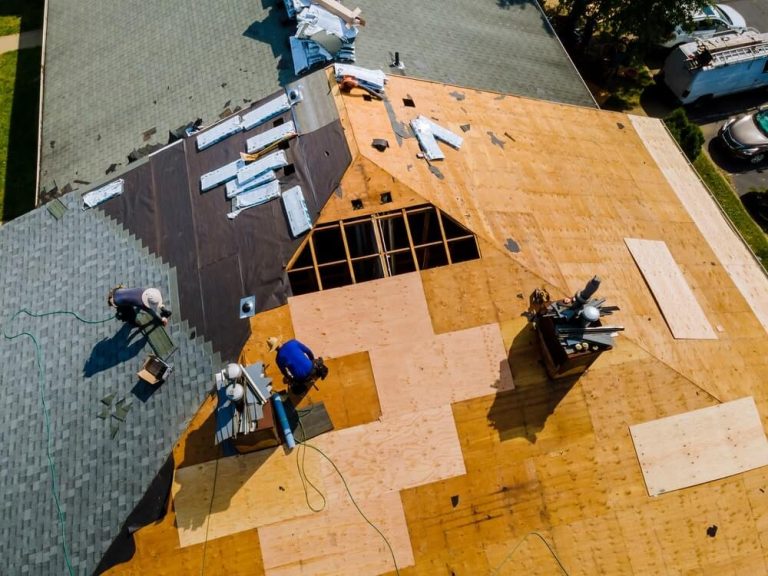Whether there’s heavy snowfall or a mild winter with only a few snow days, every homeowner in frigid climates needs to do what they can to avoid roof ice dams. Movies, TV shows, and even greeting cards depict wintery scenes with roofs majestically coated with snow and glistening icicles. However, this idyllic image is something that should put you on high alert if you see it on your roof.
At Pinnacle Home Improvement Contractors, we provide quality craftsmanship and customer satisfaction. If you want to know how to repair a roof or prevent ice dams, you’re in the right place. Our Georgia home improvement contractors offer advice on how to prevent ice dam formation and keep your roof in tip-top shape throughout the winter season.
What Are Ice Dams and How Do They Form?
Ice dams are ridges of ice that develop on the edge of a roof, essentially blocking melting snow from flowing away from the home. When an attic space lacks proper insulation, heat escapes from it into the roof, causing the snow to melt.
This water, created by the melting snow, then flows down the roof toward the eaves, where the surface is much colder. When the water gets to this part of the roof, it refreezes, which creates ice dams, a ridge of ice that blocks the rest of the water from flowing off the roof and into the gutters.
When ice dams get too large, they block all water drainage. With nowhere else to go, the water backs up and pools onto the roof. Ice dams form due to warm air on the roof surface that traps water on the roof, letting it get under the shingles, into the attic, walls, and ceilings.
Risks and Damage Caused to Homes by Ice Buildup on Roofing
In northern climates, ice dams are common on a roof’s edge, but they are a huge problem that should be addressed immediately by homeowners to prevent significant damage. When ice dams form, a variety of serious issues can impact your home.
The most pressing issue is structural damage. The added weight of ice and snow can be too much for your roof to bear. That damage can also extend to the gutters, pulling them away from the roof, and can destroy the foundation, too. Ice dams may also lift your shingles, which lets water penetrate the roof deck below.
When ice dams melt, the water can seep into your attic space. Your insulation may be rendered ineffective. The water from ice dams may also flow through your ceilings and into your walls. When wood is a common material in the attic space and other parts of a home, mold and rot often develop as a result.
Homes will suffer the most damage from ice dams, though you and your family are also in danger of injuries from icicles. In rare cases, they have even caused death. If you thought freezing temperatures were going to be the worst of winter, it is time to get to work and prevent ice dams to keep your home and family safe all season.
Ways to Prevent Ice Dams on the Roof
What can you do to stop ice dams? These preventative measures can help you avoid ice dam damage to your property:
Reduce Heat Loss from Your Home
Heat loss from the living space in your home needs to be addressed to stop ice dams. In order to stop this phenomenon, you need to improve your attic insulation. Adding insulation to your attic floor keeps the heat in your living space where it belongs. It should also be noted that when adding insulation, choosing materials that have a higher R-value is ideal.
You can also prevent heat from escaping and causing ice dams by ensuring air leaks are sealed in the attic. Common points that allow heated air to escape are around vent pipes, the chimney, and attic hatches. If your home is older, you can benefit from having professional air sealing in the attic and around all the other common points where air leaks develop.
Improve Your Roof’s Ventilation
Another reason you may see ice dams on your roof is due to a lack of proper roof ventilation. It’s worth having an inspection to check that soffit vents aren’t obstructed by insulation and ridge vents aren’t clogged with debris. A professional can assess soffit vents at the eaves and ridge vents at the peak, ensuring your roof system gets the right airflow to keep its surface cool to prevent melting snow.
Stay On Top of Snow and Ice on Your Roof
Snow and ice might look pretty, but they add weight to your roof, putting more strain on the system. If there is warm air making the snow melt into water, you may soon contend with ice dams. When snow falls, get a roof rake and use it to remove snow from the edge of the roof. A roof rake is an excellent tool for reaching the overhangs where ice dams usually form.
Keeping your gutters and downspouts clean is another way to ensure that water can flow from your roof and away from your home. With proper drainage, ice dams can’t form.
While Georgia doesn’t get as much heavy snow as more northern locations, homeowners in areas that are more prone to ice dams can use heat cables. Professional installation of heat cables on the roof edge helps melt ice and prevent ice dams.

Benefits of Professional Inspection and Maintenance Services to Prevent Roofing Ice Issues
With professional roof inspections and maintenance services, you can prevent costly issues caused by ice and excessive snow load. Experts can identify the early signs of trouble that most homeowners would not notice. By doing so, they can help you prevent water damage and promptly address the issues caused by ice dams before serious damage is done to your home.
Inspections are crucial, as there are many things you may not realize are wrong. For example, you might be able to tell that you have some damaged shingles by looking from the ground. What you can’t see might be more damage further up on your roof, compromised flashing, and ventilation issues, which can all make ice-related roof problems worse.
Some homeowners don’t want to spend the money on inspections, though it can wind up saving money down the road. By catching these things early, you’ll avoid major repairs and extend the lifespan of your roof. Ultimately, you’re protecting your biggest investment, adding value to your home by looking after one of the most important features it has – the roof.
One of the biggest benefits you get from having the help of a professional is protection. Ice dams and snow buildup can cause a roof collapse. The added weight can impact the structural integrity, and inspections will identify potential problems that could lead to a tragic outcome.
If you want to maintain the value of your property and its curb appeal, make sure you maintain your roof. You’ll also have the added peace of mind that comes from knowing that you are as safe as can be inside your home.
Do-It-Yourself Tips to Stop Ice Dams from Forming
There are a few things you can do without professional help, depending on your level of comfort and skill. One of the most important tasks of taking care of your home in any season is cleaning your gutters and downspouts. You will thank yourself later for keeping them free of debris, and if you’re not thrilled about this chore, you can have gutter guards added to prevent leaves, twigs, and other materials from clogging them up.
Make sure you remove any snow on your roof using a roof rake. This is fairly simple for many homeowners who have a single-story home. However, if you have a two-story residence, it is safer to call a professional to help.
For homes that have high roofs, or if you don’t want to hire someone to come and keep ice dams from developing all winter, owners can have cables installed to de-ice their roofs. They will melt the snow and ice and keep water flowing. It should be noted that heating cables will work best when you make sure that your gutters are clear.














